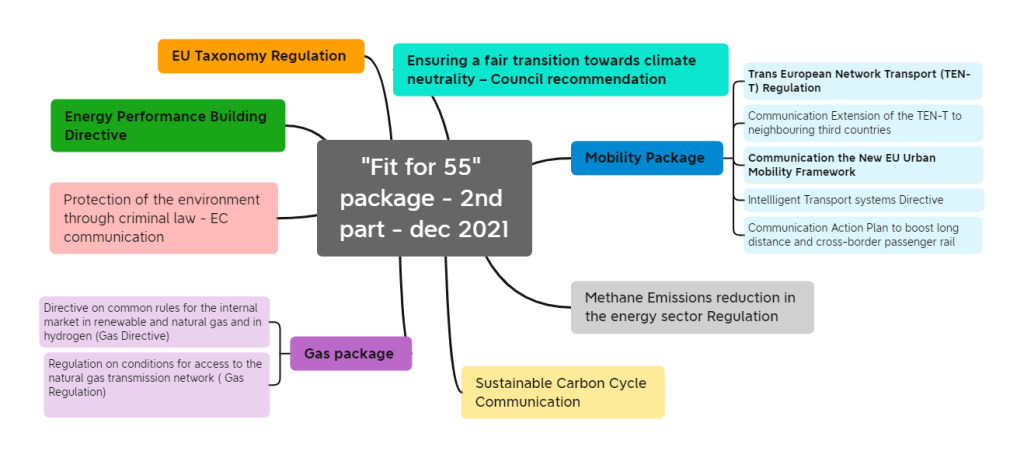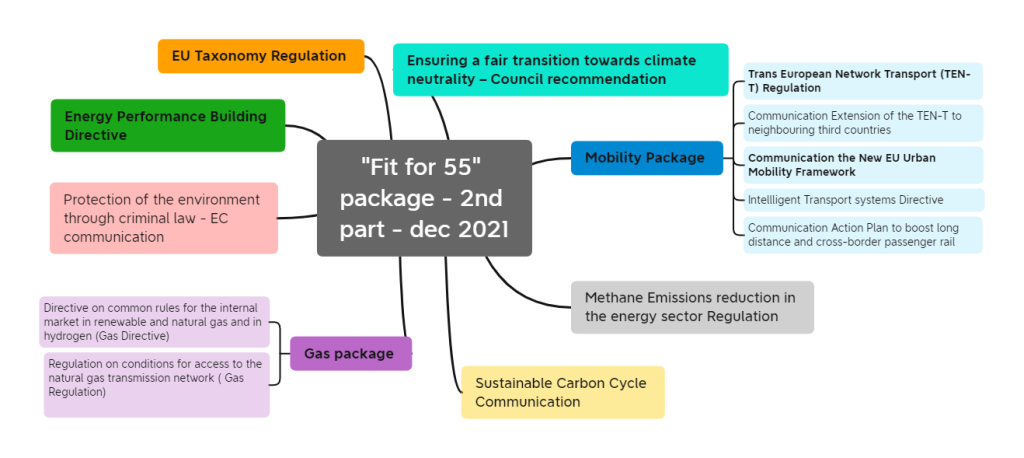Puzzle out the “fit for 55” package

Last December, the European Commission dropped the second batch of its “Fit for 55” package under the Christmas tree. Like the first part released in July which put a lot of emphasis on local authorities (see our article and webinar), this second part also includes some good elements despite falling short of delivering a structural change.
These texts will now go through the European Parliament and the Council and could therefore be widely amended before being adopted. Energy Cities will carefully follow their legislative journey. In the meantime, here is an overview of the major reforms that will matter for local and regional authorities:

Mobility Package
The mobility package is a set of four proposals to modernise the EU’s transport system and align it with the objective of the Green Deal. Cities are definitely at the core of this package:
- Cities included in the definition of “ urban nodes” (424 of them which are listed here) will be required (art. 40 Ten-T Regulation) to develop a Sustainable Urban Mobility Plans (SUMPs) by December 2025 and collect and submit urban mobility data from the same date on.
- The European Commission will review the SUMPs guidance to align them with the objectives. The main focus will be on public transport, walking and cycling as well as connected, shared mobility services.
- The European Commission will draft by the end of 2022 a Recommendation to Member States on the national programme to support regions and cities in the roll-out of effective sustainable urban mobility plans.
Hydrogen & Gas Market Decarbonisation Package
This package (a directive and a regulation) mainly aims at promoting low carbon gases and allow for more engagement of gas consumers. The word “Hydrogen” is now included in the title, showing the importance given to it by the EU executive which would be covered by a brand new EU operator. In general, this package is disappointing as it does not include strong measures to phase out fossil gas by a certain date, keeps a majority of rules untouched and does not make a clear distinction between the treatment of “low carbon” and “renewable gas”.
EU Green Taxonomy Delegated Act
The taxonomy initial goal was to prevent greenwashing while proposing a classification system to say which private investments can be labelled as climate-friendly, and thus make green investments more visible and attractive to private capital. This act has caused a lot of noise and political tensions between the pro-gas, pro-nuclear and the others while the Commission proposed to label nuclear and fossil (natural) gas a green and transition investments, failing the greenwashing combat.
However, it does not directly concern local authorities as it only concerns private and not public investments and stands only as a classification system. Although there is no direct impact on public investments, this kind of approach could obviously increase the cost of finance for these investments.
Energy Performance Building Directive
The objective of the directive aligned with the rest of the package and in particular the Energy Efficiency Directive, is to reach an EU zero emission building stock by 2050. The key points for local and regional authorities are:
- New “national building renovation plans” aligned with the National Climate and Energy Plans (NCEPs) and having a stronger monitoring framework. For these plans, the consultation of public and in particular local and regional authorities is required (art 3).
- All new public building (owned or occupied) by 2027, all new building by 2030 need to be zero emissions (art 7)
- Regarding existing buildings (art 9): introduction of mandatory energy performance standards that imply that by 2027, all non-residential and public buildings, and by 2030 all residential buildings, will need to reach at least energy class F. By 2033, all buildings will need to be renovated to at least energy class E (2030 for non-residential buildings), with some exceptions (protected building, temporary use…)
- Member States cannot provide financial incentives for fossil fuels boiler installations from 2027 (art 15) and can ban fossil fuel use in buildings (art 11).
- One stop shops and technical assistance schemes are greatly encouraged
Fair transition Recommendation
The European Commission proposed a recommendation to the Council to ensure a fair transition towards climate neutrality. It insists on the following points:
- The importance to create jobs and opportunities and ensure a social protection system for all
- The access to affordable essential services for all and especially the empowerment of energy consumers “by developing further self-supply via individual renewable energy arrangements as well as other services via citizen energy communities, accompanied by educational measures and campaigns, with a special focus on people in vulnerable situations and consumers living in rural areas”.
- The necessity to give an active role to regional and local authorities, given their proximity to citizens and local businesses, in the implementation and monitoring of fair transition policies.
Energy Cities is delighted with this recommendation promoting an inclusive and democratic energy transition notably through education, something we have been heavily campaigning for over the past months.
The post Puzzle out the “fit for 55” package appeared first on Energy Cities.
Fuente: ENERGY CITIES
Enlace a la noticia: Puzzle out the “fit for 55” package

